Text
A Diamond Trader’s Guide For Cheap Food

You won’t find a non-veg dish here if your life depended on it.
It’s easy to get lost in the bylanes of South Mumbai’s Zaveri Bazaar. Located in the 3rd agiary lane, this is the city’s largest jewellery, gold and diamond hub. Expensive jewellery shops interspersed with little food stalls that have mushroomed around them.
“This is where working class people (including rich jewelers) get good food at cheap prices after a hard day’s work,” says Akash, chef at a South Indian restaurant tossing his famous Mysore Masala Dosa.
During teatime, the bazaar is practically impenetrable. There are scores of craftsmen and traders out on the streets, devouring freshly cooked vegetarian snacks like kachoris, chaat, samosa and pudlas. Other favourites include Dayaram’s Namkeen which was started 70 years ago and is famous for its Chhappan Bhog. Mohanbhai Pudlawala was established in the year 1968 and its moongdaal pudla is a real crowd puller.
Khau Galli comes alive between 4-7pm everyday with the Gujarati, Jain and Marwadi community out in full force. This vegetarian brigade loves their tea-time snacks and vendors have seen the same faces, some of them for over five decades now.
Some changes happened after the 2011 bomb blasts that claimed 27 lives. The city’s civic body drove away several hawkers to ease the congestion in the area. But stalls cropped up again, though not as many as before. Several diamond merchants also shifted to the more secure Bharat Diamond Bourse in Bandra Kurla Complex (BKC), which meant that stall owners lost some of their most loyal patrons. But life moves on and old patrons have made way for the new.
Related: I Am A Digambar Jain And I Spent An Evening At Mohammad Ali Road
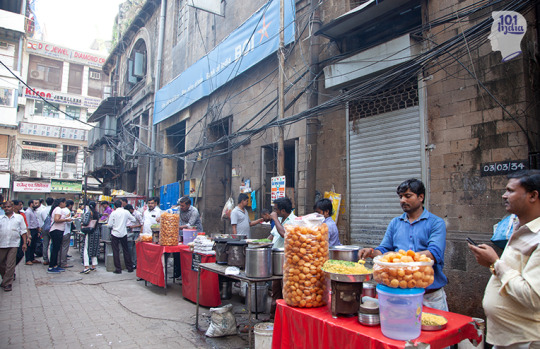
3rd agiary lane where khau galli is situated
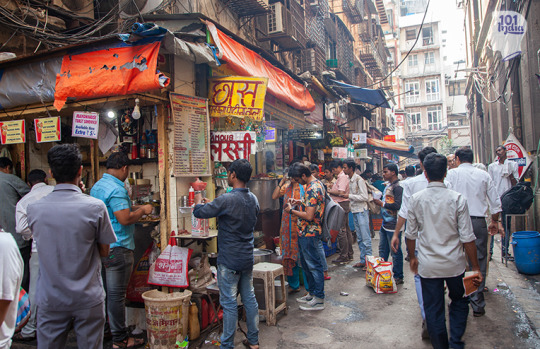
Cramped lane of Zaveri Bazaar
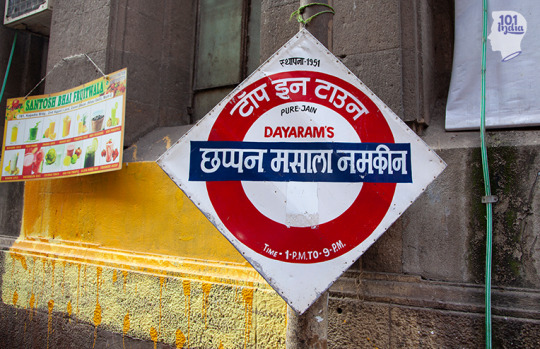
Road signs

Agrawal Fast Food famous for it’s pyaaz kachori and sev khaman
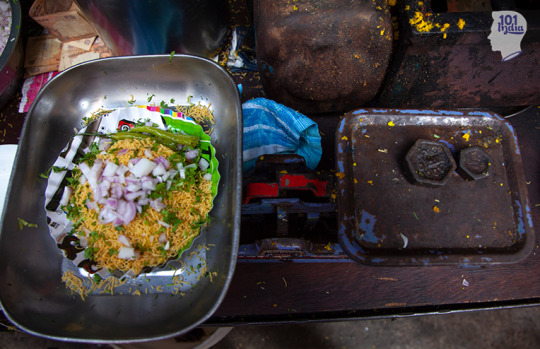
Sev khaman sold by weight
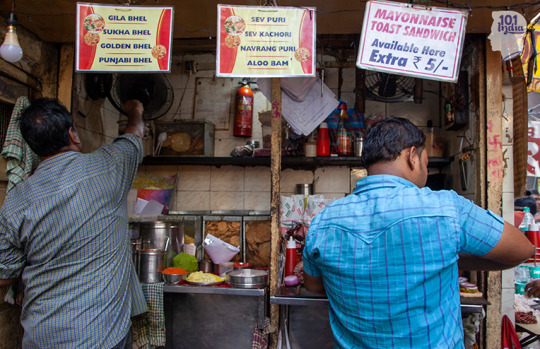
P.P Sandwich and Sevpuriwala, famous for their sev puri sandwich
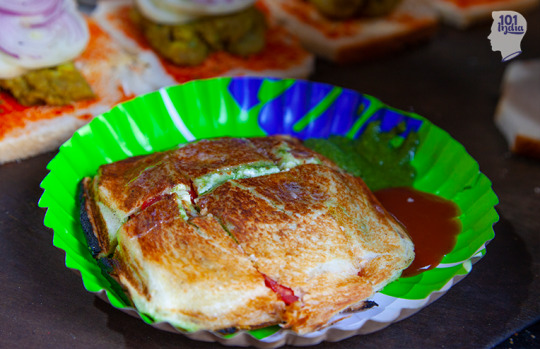
Kela (banana) chutney sandwich, famous amongst the Jain community
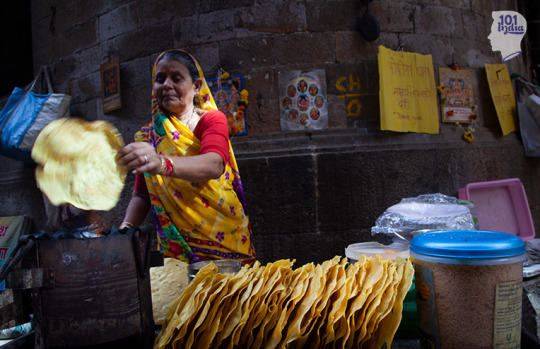
Kichiya papad in the making
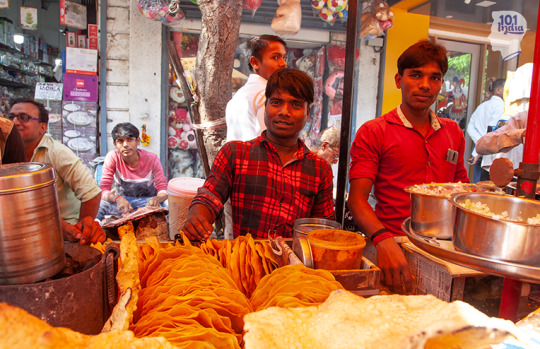
Kichiya papad
Related: 600kg Lentils, 300kg Potatoes, 40kg Onions, 10kg Ghee - The Daily Menu At The Golden Temple
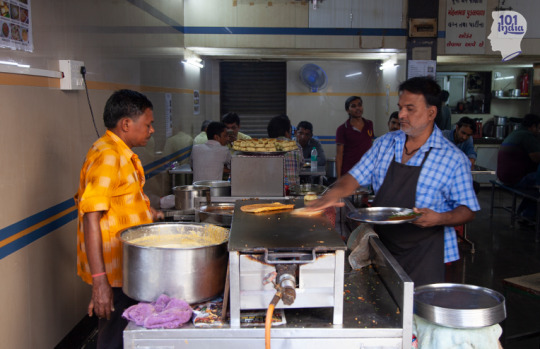
Pudla in the making at the famous Mohanlal Pudlawala

The famous pudla
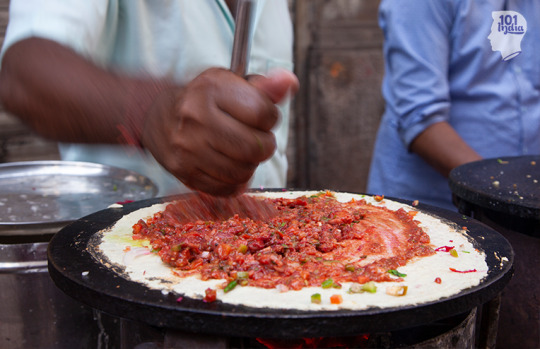
Akash South Indian making his famous Mysore masala dosa
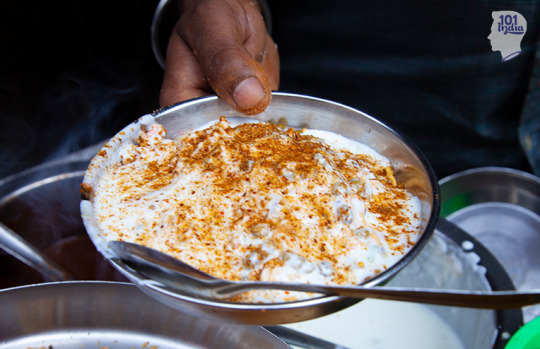
Dahi kachori
youtube
Related: A Tea-Fanatic Goes On A Pilgrimage To Find The Best Meter-Chai In Kerala
Disclaimer: The views expressed in this article are independent views solely of the author(s) expressed in their private capacity and do not in any way represent or reflect the views of 101india.com
0 notes
Text
600kg Lentils, 300kg Potatoes, 40kg Onions, 10kg Ghee - The Daily Menu At The Golden Temple

Feeding 100,000 people a day is no mean task.
The deafening sound of clanking metal plates, the manic activity of sewadars serving food to thousands of people seated neatly in rows, while outside the hall another batch of thousands line up for their meals. This is what a day at Guru ka Langar at Amritsar’s Golden Temple looks like.
I am neither religious nor spiritual but here I was, one of the million tourists who had come to seek Babaji’s blessings. In return I wanted to give back to society, even if just for today. I love the purity of community service that makes this place such a revered pilgrimage for Sikhs all over the world.

Pilgrims line outside the halls waiting for the langar
I was told I can simply walk into the langar area and ask around for work. With so many people being fed at a given time, the kitchen is always seeking help from volunteers. I wasn’t sure what to expect, but I naturally gravitated to the back of the langar halls to reach the epicenter of all the action - the kitchens.
Related: Bombay’s Sion Koliwada Colony Thrives On Partition Stories And Punjabi Food
I was anticipating sewadars (volunteers) to be in a mad rush. But what I saw instead was a certain calmness. The women were peacefully going about their business of rolling chapatis. The men were washing, cleaning, heavy lifting, and doing the usual chores. The intensity that I saw outside was not even remotely close to the stillness inside the kitchen.

Women slathering rotis with dollops of ghee
As I was looking for someone to assign me work, a man asked me to join the cooks in preparing lunch. Paramjit, the head chef at the Temple, was appointed a year ago to handle the langar. His job is to prepare the right quantities of food to feed every mouth that walks through the door, without wasting a morsel. The 26-year-old Sikh gave me a quick tour of the place explaining the process. He works in a 9 to 5 shift and prepares a complete langar that comprises dal (lentils), sabzi (vegetables), kheer (pudding), and rice. He tells me that they have a set menu for the week. “Knowing what to prepare helps us plan our work more efficiently.”
Related: India's Village Of Female Boxers | Chakar, Ludhiana | 101 Heartland

Paramjit showing me around the Golden Temple complex
As we walked through the floors, I could see that apart from hundreds of sewadars who are diligently involved in keeping the kitchens functional, there are also machines that fasten the process and make it possible for them to feed thousands at the same time. The roti machine can churn as many as 5000 an hour!
The more I saw, the more I was impressed. How are they able to prepare so much food and keep serving the endless line of visitors at their doorstep? Paramjit explained that they start preparing meals the night before. The preparation for the first batch of lentils - 400kgs - starts at 12 AM the previous night. This is cooked till 6 AM. The next batch starts at 11 AM, then at 3 PM, and then the final one of 200kgs at 9 PM which usually lasts them through the night due to thinner crowds.
“But, that’s too much food!” I exclaim with disbelief. Paramjit grinned and said at least one hundred thousand people come every day to eat. He also added that the food in Guru ka Langar is not bought but is offered by its devotees. The Temple is run by people and their faith. All the farmers in Punjab donate the first harvest as an offering, believing that this selfless donation will give them healthy crops and prosperous harvest through the season.

The roti machine
By now I was more than ready to do my bit and feed the hungry. Paramjit introduced me to another cook I was going to assist. He guided me to four large cauldrons filled with cut veggies all the way to their neck. I stood at its base, peering down at the container with a heavy ladle dangling from it. The cook told me to start stirring the veggies after every 2-3 minutes and walked away. It was so heavy that for the first few seconds I couldn't get a grip. The cook came back as he saw me struggling with the ladle, took it back from me, and started stirring it in the pot easily.
I stood there, ashamed, and asked for another chance. He handed me the ladle again and this time I managed better. Now it was time to prepare a fresh batch of vegetables. 40kgs sliced onions, 6kgs green chilies, garlic, and ginger. Stirred into 10kgs pure ghee. For tempering we added 3kgs turmeric, 700gms garam masala, 7kgs salt mixed in 300kgs sliced potatoes with 10kgs soybean nuggets. Ingredient after ingredient was transferred into the cauldron and I could already smell all its flavors.
Related: Greyhound Racing In Punjab | 101 Heartland With Doctor VC
It was now more than three hours that I was in the kitchen. They made me do one task after another, from washing dishes to spinning the ladle to bringing the ingredients. I was running around in all directions, covering my head, wiping beads of sweat from my face and hair. It was 40 degrees inside the kitchen.

Washing up (with a hosepipe)!
Finally, when everything was done, I sat down in front of the sole fan and was given a large serving of Prasad. I thought of it as a generous reward for my day’s labor and thanked the universe.

The magnificent Golden Temple
When I came to Golden Temple that day, I didn’t know what to expect from the world’s largest community kitchen. The dedication, selfless devotion and spirit to serve was beyond anything I had every experienced. I think I can honestly say I have come away a better person from my interactions with the people there.
Disclaimer: The views expressed in this article are independent views solely of the author(s) expressed in their private capacity and do not in any way represent or reflect the views of 101India.com.
By Kanika Gupta Photographs by Kanika Gupta
0 notes
Text
Dreamline: A Walk In The Sky | 101 Subway
youtube
Rohit Vartak's balancing act, hundreds of feet in the air.
Highlining is an extreme version of a sport called slacklining, in which athletes walk across a 1-inch wide springy band of rope, suspended high above the ground. Rohit Vartak is one of the first Indians to take to this daring sport. The goal is simple: walk across this thin band, usually from one cliff to another. It's like tightrope walking, except the rope is bouncy, and the wind is trying to knock you off. With highlining, usually it's not a matter of if you will fall, but when. Because the shortest route from one cliff to another, is also the scariest.
101 Subway takes a look at people whose beliefs, values, styles, and attitudes differ from that of the prevailing culture. Subway looks at India’s evolving sub culture scene across trends like Cosplay, BMX, Graffiti Art, Street Art and even the culture of weed.
0 notes
Text
The Scoop, A Little Ice Cream Parlour Looking Over The Ghats Of The Ganga | 101 Traces

Enjoy a sundae with a sunset before it’s too late.
It seems like yesterday, but it was more than 20 years ago, sometime in the mid 90's. My extended family and I crammed into the old White Ambassador. It was no mean feat, there were 9 of us. We rolled through the not so dirty, freshly green, post rain, winding lanes of the City of Joy. We hopped off at the majestic gates of the white beauty - Victoria Memorial, slowly strolled through the verdant gardens, were dazzled by the musical fountain show in it's backyard, and finally ended the evening with big scoops of butterscotch ice-cream, or a chocolate sundae (if it was a really special occasion), in a tiny nondescript two floor building above the Ghats of the Ganga called the The Scoop.

The Victoria Memorial. Image source: wikimediacommons.com
Yes, The Scoop not The Scoop Cafe. They are as no nonsense with their name, as they are with their menu that back then served only ice-cream and French fries, and décor that till today comprises of the most basic plastic tables and chairs.
Related: Bombay’s Sion Koliwada Colony Thrives On Partition Stories And Punjabi Food
Looking at the sunset streamed colours filtering in through the glass windows, lost in the haze of the little dinghies floating past us on the shoulders of the mighty Ganga, ice-cream streaming down our faces and hands, my siblings and I had the most content smiles on our faces. This was the hallowed ‘best day of the year' that we eagerly waited for every year, with overflowing suitcases slammed shut with jumping dances, and a day's journey rattling on a train that sometimes extended to two days. We the Probashi Bengali's had returned, and the pukka Calcutta Bangali's were giving us a slice of their beautiful city, served with a coaster on the glassy banks of the river. This was a yearly ritual for us. For the uninitiated, the word Probashi literally means someone who lives outside, and a ‘Probashi Bengali' is a Bengali born and/or raised outside Bengal. My family and I were exactly that.

My comfort place. Image source: justdial.com
For many years The Scoop remained a place of perfection, carved in my head in its rectangular sturdiness, with all the sweetness of innocent childhood memories. Then teenage happened, and the Probashi's returned to settle down in Calcutta. Soon it was rechristened Kolkata, and The Scoop too regained a whole new aura. A boat ride led my friends and I to Babu Ghat again, and remembering the old days I strolled in with them to revisit the good old times. But new memories were waiting for us, eager lovers vying for a corner seat so they could hold hands under the table, sharing a sundae to give college brokeness the tinted beauty of romance. We shuffled through the years, ignoring the pilling grime on the tables, the fading wallpapers, the peeling paint and the rusty shutters. The Scoop settled back into the memories of a diary for me, and I set sail for new shores.

Old school love. Image source: tripadvisor.com
Years went by, boat rides with stolen kisses were exchanged for the comfort of nostalgia by the Ghat. Cemented in a firm today, The Scoop stood there as a gauging old love, sizing up the new husband, as I walked in with him one day. We still had to stand in line for a token, and then again for the swift sundae whipped up with dexterous unwashed hands. We still had to walk up the carpeted narrow red stairs, and vie for a quiet corner seat with a view in the musty glass house upstairs. We still had to keep our ears pricked, to hear if it was our number to go and get the French fries from below. And we could still peer through the glass (ignoring our reflection), at the darkening river bringing home the dinghies on a grey monsoon evening. A bright new PVR shining across the shore on the other side of the river was the only new addition in this house of memories, along with a few new eatables like sandwiches and pizza on the menu.
Related: Monica Liu: The 'Don' Of Chinatown | 101 Traces
The Scoop remains staunchly simple, in the food they serve, their ambience and their rigid refusal to join the rat race of advertisements. The paint may have peeled more, making home for mould; the posters may have faded the red Kwality ad's into a subtle pink. But it’s still home, still old-school, still uncompetitive, still standing tall in all its austerity.
Come if you please it states, with the bold directness that only time-honoured establishments like Kayani's, Britannia & Co., or a Goodluck Café can flaunt. How old is this little ice-cream parlour? Maybe 30 years or 40, Google is a bit unhelpful about this, but it has been with me long enough to leave an impression for a lifetime.
You can visit this hidden piece of Kolkata at 71, Strand Road, Dalhousie BBD Bagh, right next to Babu Ghat. Any of the single scoop ice creams are good value for money. If you want to splurge, you can go for the ice cream sundae. My personal favourite is ‘Cookie Crumble', but ‘As You Like It' is another great option, as it allows you to select any 3 scoops of your choice. You can take a romantic pre-sunset boat ride, and then enjoy a sundae with a sunset in this noisy little ice-cream parlour, unchanged with time.
Related: Into The Kitchen At Nostalgia, Margao
Disclaimer: The views expressed in this article are independent views solely of the author(s) expressed in their private capacity and do not in any way represent or reflect the views of 101india.com
By Rhea Purnita Paine Cover photo credit: pixabay.com
0 notes
Text
Smoking Chillums And Hanging Out With The Naga Babas In Pushkar

Learning the art of detachment.
Pushkar has always had a special place in my heart. Special enough to make me go there every year for the past five years.
During my last trip, I hung out with the Naga sadhus and saadhvis at the Tarani Ghat. Now I’m a solo traveller, and a loner at best, but what I experienced here was detachment to another level.
Parvati Devi, a saadhvi and devotee of Shiva made the decision to renounce the world at the young age of 9. Her belief is that everything is temporary and fake except God. And the only way to escape the endless cycle of birth and death is to follow a path of detachment and acceptance. “Is duniya mein sab kuch moh maya hai.” The disciple must not only learn to stand apart and hold herself free, but also learn to cultivate the attitude of an onlooker and silent observer.
100 year old Kedargiri Baba gave me an insight into his life. Clothed in orange, which symbolises renunciation of the commitments of ‘normal’ life, he said sadhus are constantly on pilgrimage, travelling long distances across India. Their belongings are stripped down to bare essentials, though carrying a metal rod or spear as a devotional object like he does, seems to go against the idea of travelling light. There are other recognizable signs, long hair in dreadlocks, wound around the top of the head.
His ashram was a three storey building with a courtyard. I spent most of my time here, ruminating over life and chillums.
Related: Into The Kumbh: In Search Of A Naga

Parvati Devi, a saadhvi and my guide

100 year old Kedargiri Baba

Most of the day is spent in meditation

Saint Niranajangiri also known as Mouni Baba holding his spear

My welcome at the entrance of the ashram
Related: In November, Pushkar Becomes The Most Un-Deserted Desert In India

Guruji

Reflecting over life with chillums

The place spells peace and harmony

Making prayer beads

The youngest sadhu (centre) is 15 years old

Cozy conference

He had the longest dreadlocks

When not meditating…
Related: The Pushkar Camel Fair Might Soon Have To Drop 'Camel' From Its Name
Disclaimer: The views expressed in this article are independent views solely of the author(s) expressed in their private capacity and do not in any way represent or reflect the views of 101india.com
By Rashi Arora Cover photo credit: Mohan KK Photographs by Rashi Arora
0 notes
Text
Two Girls Accompany Paranormal Experts To A Haunted House

Hunting spirits and busting myths at Panvel.
It was full moon. I was told not to get involved with unknown energies. But I have an unhealthy interest in the paranormal. So I went, and it was nothing like I imagined.
“Media se hain. Photo nikalne aaye hain,” (We are here from the media to take pictures) Sarbajeet says slyly to the security guard who gives us an inquisitive look as we trespass into his property. It’s not a complete lie. The photographer and I are media. But we are also guests of Sarbajeet Mohanty and Pooja Vijay, co-founders of P.A.I.R.S (Parapsychology and Investigations Research Society), who have invited us for a paranormal investigation. Like any other investigation, this one aims to reach rational conclusion through a scientific approach about a supposed paranormal phenomenon – simply put, the presence of a spirit or ghost. These guys are certified experts and we are outside an abandoned commercial colony in Panvel.
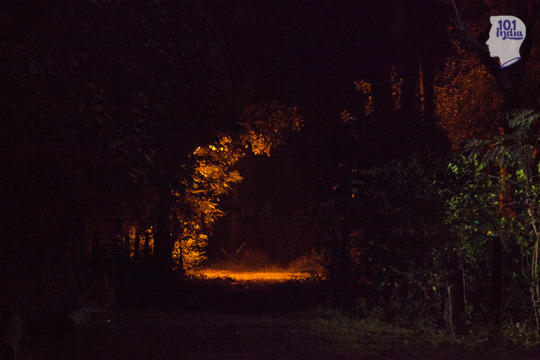
Entry to the haunted house
“Friends tipped me about this location. They felt a certain heaviness here, like someone was lurking around. They think they saw an apparition in the dead of the night,” Sarbajeet states looking around. The 21-year-old who claims to be the world’s youngest certified demonologist doesn’t seem to know much about the place. Neither do we. The bungalow was vacated years ago. Apparently it used to be an office, but was deserted for unknown reasons. Which is why we want to understand the paranormal phenomenon here, create a portal to contact the spirit, hear her side of the story and help her crossover.
Related: At A Small Dargah In Mumbai, You’ll Find Demons, Exorcism, Faith And Fear
It’s a warm night. With just the moon guiding us, we enter the colony. There are no gates, but lots of trees. It is separated from the main road by a short compound wall. A cobbled path leads inside beyond the guard’s room to a tiny temple which lies empty, dilapidated and eerie looking. Dogs bark in the distance to add to the spookiness of the experience. A white cat scurries along the bushes but stops momentarily to give us an evil gaze. I can see the fear on my friend’s face. Perhaps she can see the same on mine. Sarbajeet and Pooja seem unfazed.

Surrounded by bats, rats and ghosts
Sarbajeet tells me the last time he was here he was able to establish contact with the spirit of a lady. “What do you mean by contact?” I ask. Pooja, who is a psychic, past life regressionist, reiki master and an investigator, explains the physics. Apparently, unlike films, it’s not easy for us to see the spirits or hear them. Since they do not have a physical body, it requires a lot of energy to even hear them. “We ask them to give us hints of their presence by making simple actions,” Pooja adds.
Before heading into the house, the duo acquaints us with the equipment. There are two torches to guide us through the night, temperature readers to monitor fluctuations that occur in the presence of the spirits, a pair of walkie-talkies in case we get separated and most importantly EMF sensors to observe earth’s magnetic fields. Sometimes the spirit will use the energy of the earth to establish contact with the living and thereby disturb the earth’s magnetic field. The device will sense that and blink with a red light. “For example, I tell the spirit if you are here, please blink on the sensor three times,” Sarbajeet demonstrates by holding up the device. Suddenly, three red lights blink on the sensor. I am taken aback. Even Pooja seems surprised. “Looks like this is our welcome,” Sarbajeet chuckles.
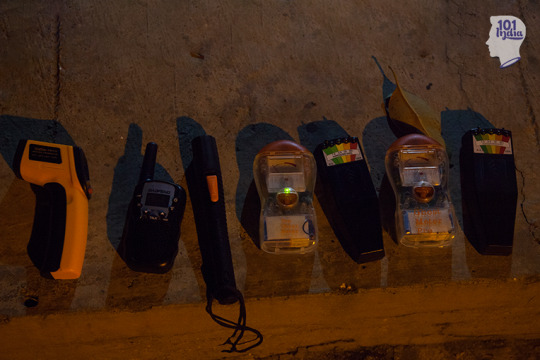
The equipment used to detect spirits has to be imported from the US or UK
I was nervous and excited. The real investigation hadn’t even begun and I could already sense the presence of someone, or something. We finally make our way into the first abandoned shanty. Most walls are broken. The others are cracked. The ceiling is gone and a huge tree looms over us. Its branches have crept into the house through holes in the wall and window sills. The floor is filled with muck and dry leaves that crumble beneath our shoes. There are spider webs in the corner, and there’s four of us in the centre of what must have been the living room of the house, hoping to catch something.
“If you are here, please give us an indication. Please blink the EMF as you did outside,” Sarbajeet says talking to the supposed spirit in the room. I keep my eyes fixed on the sensor that is placed against the wall. Nothing happens. Pooja repeats the same. Still nothing. There’s an eerie silence. “Umm..can the spirit understand us?” I whisper in Pooja’s ear. Responding in the affirmative, she explains that they connect on a telepathic level. “Language does not matter. Though they may be more forthcoming if they hear a familiar dialect. Why don’t you say something in Marathi?” she suggests, nudging me.
So here’s one of the many firsts. My first conversation with the living dead. “Ithe koni aahe ka. Indication dya. Nusta bhetaila alo. Traas nahi denar. (If there’s anyone here, give us an indication. We are here only to meet you, not to trouble”) I say awkwardly. Nothing happens. Honestly, I am a little disappointed. I would have felt special had the spirit chosen to communicate with me.
After waiting a few minutes, we decide to explore other parts of the house and walk through a narrow corridor. I can feel a mild change in temperature. It is much cooler in the corridor than the living room which is hardly three steps away. Suddenly I hear a rustle of leaves. There’s no wind. Perhaps it’s an insect? Heading back to the living room Sarbajeet again pleads, “If there’s anyone here, please give us some kind of signal.”
THUD! There’s a loud sound from behind. Shaken, I turn around. It sounds like a heavy footstep. Pooja and Sarbajeet spring into action. “If that is really you, could you do it again please?” Pooja requests. Within seconds there is another thud, much lighter than before. “Thank you for responding. Was this house yours? If yes, please blink into the EMF. If not, you may knock.” We wait five minutes and hear another thud in the corridor. Thinking that the spirit has left and perhaps wants us to do the same, we decide to investigate the next house.

Any takers for a haunted one BHK?
Almost at once we notice our fully charged devices including cellphones and cameras are drained of 60% battery. “The spirit has used it.” I shake my head and look at the second house that seems spookier and is accessible only through a path lined with ruined broken walls and bushes. Treading carefully I ask Pooja, “What if the spirit does not want to communicate with us?” “Then it won’t. Just because they are dead does not mean they don’t have moods. They have the same personality they did when they were alive. So they’ll do what they want.”
This was news to me. Reading my mind Pooja continues, “This is why we want to create awareness. Not all spirits are evil. Some are just lingering. Some are confused. They do not know they are dead. Sometimes we need to make them realise that and help them crossover.”
Related: The Old Bastora Road | 101 Great Indian Ghost Stories
The second house was like a one BHK. The ceiling, a tin shed, is intact. There’s just one window which is sealed. Feeling claustrophobic and uncomfortable, I think of all the scary stuff from horror films. Will I see a ghost staring at me from the window? What if something attacks me from behind, or worse, tries to possess my body? Thankfully, my thoughts are interrupted by a squeaking sound. I hear something move amidst the dry leaves. It's a rat. I shriek! This is more terrifying than a ghost.

Sarbajeet initiating conversation with the spirit
I see Puja fumbling with the temperature reader. “Look how fast it is fluctuating,” she says. Withing seconds the reader drops from 26.8 to 25 degrees. Sarbajeet places the EMF on the floor and begins a conversation with the spirit. “Last time, I was here, I had spoken to a lady. Are you still here?” There is no response. “Please give us an indication of any kind,” he adds. I repeat the same in Marathi. Suddenly something falls on the ceiling. Is it the spirit?
“Is that you. Is this house yours?” Sarbajeet asks again. There’s no response. “Do you want us to leave?” Again, something falls on the roof. Probably a bigger rock making a stronger sound. The message is loud and clear. I hurry outside and the rest of the team joins me. We don’t want to anger the dead.
But Sarbajeet is in the mood to play a little more. We turn back to the old house. “Why don’t just the three of you go in? Maybe it will react differently to women.” We walk in, this time with a spirit box which is a mobile app fed with Hindu scriptures that have been reversed. When switched on it continues saying words that don’t make sense. “Are you male or female?” “Female,” it says amidst the gibberish. I am astonished. “How many of us are here?” “Teen,” it says. “Do you want to talk to us?” “Nahi na,” it answers. “Should we go?” “Bye…see… you,” it says in gaps.

The Spirit Box has been created with the help of international paranormal organisations
I hurry out, spooked. We had an actual conversation. This app is genius.
“For our actual analysis, we will listen to the recording of words in slow motion to understand any other messages we may have missed and then make a report of the investigation. But that will take some time and perhaps more visits,” Sarbajeet says.
Related: Marna Mana Hai | 101 Phir Se Ramsay
In my head I am still processing everything, putting faces to words. Yes, this investigation has busted myths. It has made me more accepting about the supernatural. It has made me realise that spirits are not always negative and something to be feared. I head home wishing I had seen the spirit or atleast an apparition. Never mind though. It has seen me. As long as it hasn't followed me back.
youtube
Disclaimer: The views expressed in this article are independent views solely of the author(s) expressed in their private capacity and do not in any way represent or reflect the views of 101India.com
By Priyanka Kapoor Photographs by Rashi Arora
3 notes
·
View notes
Text
The Muslim Boy Who Plays Sita In Ramlila

Neither sex nor religion stop him from pursuing his dream.
Twelve years ago in the small town of Manimajra near Chandigarh, as the ten-headed Ravan went into flames, a fire burned in a young boy’s heart. Seven-year-old Miraz Malik was watching Ramlila for the first time. Hooked not just to the story, but also the characters and visuals they created on stage, Miraz hoped to be involved in the drama someday. A few years later his dreams came true and the 19-year-old Muslim teenager got the role of Sita.
His participation in Ramlila has been a defining part of his life. Currently pursuing a Bachelors in Technology from Chandigarh, this fair and slightly lean lad started off by playing the supporting role of Angad. But his director, a person Miraz holds in high regard, recognized his raw acting talent and asked him to switch to the role of Sita. “I don’t know what the director saw in me and why he felt I should play the role of a woman, but I was young then and I didn’t mind. I was happy to play the lead role.” People from different professions and backgrounds practice months in advance to perform the mythological epic of Ramayana which climaxes with the burning of Ravana’s effigy on the festival of Dussehra.
Related: The Man Who Would Be Ravana | 101 Heartland

Bold and beautiful on stage
But the peculiar part about this festival remains that most roles, even those of women, are played by men. Though times are slowly changing, this practice continues, perhaps owing to the patriarchal mindsets that do not like to see women on stage.

When not playing Sita, Miraz likes to work out in the gym
“Our practice goes on late into the night. I think this is why women are hesitant to participate,” Miraz reasons, admitting that he has never given this bias much thought. He tells me that he does as he is told. “I am a Muslim. But so what? I believe the spirit of all religions is essentially the same.”
Related: I Met The Muslim Hair Makers Of Goddess Durg
Miraz isn’t the only one. For centuries, Muslims have not just been playing important roles in Ramleela, they’ve also been closely associated with its production. Right from art direction to setting up stage and creating effigies, their contribution to Ramleela are not just crucial, but also acceptable. Though over the last few years, extremist Hindutva groups have tried to stop this. Allegedly Nawazuddeen Sidiqqui had to pull out of Ramlila after Shiv Sena members protested. Nevertheless, in several places across the rural and urban spectrum, Ramlila continues to serve as a uniting ground for both religions.

During Ramlila, they practice their religion but abstain from non-veg and garlic. Image source: hindustantimes.com
Miraz has unconditional support from his family. He tells me that it was his father, an Ayurvedic doctor, who had taken him to see Ramlila for the first time and encouraged him to join the Azad Dramatics Club that put up Ramlila productions in town. “I am a celebrated actor in the community today, because of my father.

Most are men playing the role of women
Defying gender roles, adapting to a feminine character and dealing with the usual mockery that accompanies it, is something that Miraz tackles every day. But he’s lucky. “I remember the first time I was assigned to play the role of Sita, I was teased by my classmates. But after my performance, they were rather impressed.” Playing Sita has also got him a fair share of female attention.
What Miraz struggles with most after five years of playing Sita is draping a saree and putting makeup, a ritual that takes hours. But once he’s ready, it's a complete transformation. He is no longer a teenage boy but a beautiful queen, a goddess to his audience. “It’s a little embarrassing and funny when people come and touch my feet after a play. It’s weird and empowering at the same time.” Ask him what he thinks about the story of Ramayana and Miraz says he believes in it completely. “If I didn't, I don't think I could be so convincing on stage.”
Though he wants to continue being associated with Ramlila, he understands his body is changing and soon he may have to discontinue playing Sita. But not this year. The 19-year-old has his dialogues on the tip of his tongue and is all set to take the stage. He isn’t the least bit nervous. "Let the show begin!"
Related: Meet The Muslim Crusader Fighting For Hindu Temples
Disclaimer: The views expressed in this article are independent views solely of the author(s) expressed in their private capacity and do not in any way represent or reflect the views of 101India.com
By Devyani Nighoskar Photo credit: Miraz Malik
0 notes
Text
At A Small Dargah In Mumbai, You’ll Find Demons, Exorcism, Faith And Fear
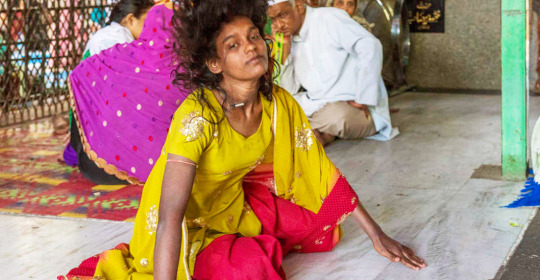
A tryst with the possessed and the paranormal.
When I was 14 years old, I wanted to be a ghostbuster. I had consumed every R.L Stine book, binged on one too many American and Japanese horror movies and argued with enough people about conspiracy theories of the parallel universe to believe in the supernatural. After pursuing metaphysics, I wanted to join the World Paranormal Society. I had it all figured out. Well, except for a concrete method to convince my parents.
Of course, they refused and asked me to pursue something more real and positive. So I became a journalist. That’s another horror story altogether, a tale for later. But one of the assignments I did recently got me up close and personal with the very dark, forgotten dream of mine - when I visited the popular Mira Datar Dargah at Reay Road in Bombay.
Located in a narrow lane behind public shanties, the 75-year-old establishment done up in shades of green and grey with holy Urdu scriptures running across the wall, is characteristic of a typical Dargah. But what is atypical is the possessed people brought here to be rid of their demons, the ‘shaitaan’.

Releasing the evil spirit?
The demons were certainly alive and kicking when I walked into the Dargah through a colourful market selling green chadars, holy threads, rose water and books. It is early afternoon and people are sprawled all over. An aged woman is rolling on the floor. She seems to be in pain. A young girl in her twenties is rotating her head at full-speed. Her thick, long braid is no longer an object of beauty, but a powerful weapon. One man has his wrists handcuffed to a railing. He is sitting quietly with a blank expression staring into oblivion. Another man is howling, shaking himself vigorously. He is held by two other men who are visibly scared but also hopeful - the two emotions that run deep within this space. The former for having lost control and the latter for being healed by the blessings of Syyed Mira Baba at the Dargah.
Related: So Long, Sister | 101 Great Indian Ghost Stories

The holy thread that supposedly cures all ailments
I don’t see the Baba anywhere. Nor does anyone else. I am told that nobody needs to. “All you need to do is tie the thread, make your wish, have some holy water and get the troubled and the possessed to the dargah every Friday for 40 days. Your faith in the baba and his powers will heal your loved one,” says Kareem who has been doing odd jobs at the dargah for 10 years. He has seen almost 10,000 people coming in every day. Some come to pray for their well being, some to get healed of the usual mental, emotional and physical ailments, but most come to get rid of demons, many of them self made.

Will faith heal?
I witness this first hand when I come across Danish Khan. The 23-year-old’s body was taken over by an evil spirit last year, something he blames his dirty habits for. Danish was out drinking with his friends late one night when he suddenly felt the urge to empty his bowels. He walked unsteadily and parked himself under a huge tree. As he finished, he felt a strange sensation taking over his body. Fists clenched, he got up - powerful, violent and trembling, running across the streets, yelling and hitting out at everyone. His friends tied him up and took him to the dargah the next morning, where he suddenly collapsed. When he gained consciousness, he felt light. “I had been freed of the evil, and also my drinking habit,” he tells me.
Related: Real Life Ghost Tales From A Real Life Receiver
I see a lot of suffering at the Dargah, but also freedom from it. My thoughts resonate with Shaqib, a 65-year-old man who has been getting his sister Khusrima to the dargah every Friday since a year. After Khusrima was supposedly possessed, she withdrew and stopped talking or acknowledging anyone. She was first taken to a psychiatrist. The treatment helped a little, but she made a speedy recovery only after she was brought here.
"Why do you think it’s possession and not a mental disorder?" I ask curiously. “We don’t know if its a demon or a disease. All we know is that it’s evil and unwanted and that we want her to be fine,” he says.
The sentiment prevails. It’s what made Prasad, a young lanky fellow, bring his brother. The brother is the same man I had seen hitting Prasad outside the Dargah. I try to speak to him, but Prasad advises me against it. I agree. His brother’s gaze is scary.

Demon or disease?
Minutes later though, something even scarier happens. As I’m about to leave, a young burkha clad woman comes running through the streets. Her body is shaking, her face fearful, she seems out of control. I don’t realise I’m in her way but she does. Pulling my hair, she pushes me to the side, runs ahead and falls down at the Dargah door. I put my hand on my head to feel my hair. It seems only a little out of place. I realise that the tug wasn't very aggressive, but the unexpectedness of the action leaves my heart pounding. I look at the woman. She is wailing and rolling on the floor. I suddenly forget about myself and think of her. She is taken in. I don’t spot any family members around.
I walk out, thinking how faith is a healer. And my lack of it. Perhaps life would have taken a different path if I had faith in my dreams.
Related: Parde Ke Peeche: A Tribute To Ramsay
https://www.facebook.com/101India/videos/2144363512449218/
Disclaimer: The views expressed in this article are independent views solely of the author(s) expressed in their private capacity and do not in any way represent or reflect the views of 101India.com
By Devyani Nighoskar Cover photo credit: naukrinama.com
0 notes
Text
Rumoured To Be The Last Of The Master Race, The Aryans Are Tall, Blue Eyed And Blonde

A week with the Brokpa tribe.
Recently I went for a trip to Garkone, a village in Kargil District. The purpose of the trip was to collaborate with people from different backgrounds to create a community based project for the Aryans. We were a team of people from various fields - design, filmmaking and research. The week long program was planned keeping adequate time for acclimatization.
During our time here, we lived in traditional homestays with the locals. Also known as Brokpas (Brok' means hillock and ‘Pa’ means inhabitant), they are rumoured to be the ‘last pure specimens’ of the Aryan race. Across the world, people still regard them as the master race—tall, blue-eyed blondes endowed with superior intelligence and values.
The area I was in, is laid out as a cluster of 4 villages perched on top of the rugged cliffs of Batalik sector, with the Indus river flowing by. The Brokpas are said to be descendants of the Dards, of Indo-Aryan stock, who came down this river centuries ago. Post-Kargil, out of the four Aryan villages only two could be accessed after clearance from the Home Ministry. These villages fall in the inner line drawn by the Army.
My story starts from Gilgit and ends in Ganex. Interestingly, the story of these villages revolves around three brothers - Dulo, Melo and Galo. Garkone, the village we visited, has 90 houses belonging to the 7 original families.
As part of their livelihood, the Brokpas grow apricots. Earlier they would barter these for salt. But now commercialization has fuelled the local economy and each apricot tree fetches a household about Rs. 30,000 annually. Abundance of goats, butter and milk are believed to be the indicators of wealth and prosperity. My diet here consisted of goat milk, goat buttermilk, goat butter, wheat, roasted barley flour, spinach and sesame. I also tried their local drink ‘Chhang’, a traditional preparation of barley and salted butter tea. I felt special because they usually make this only for various occasions like birthdays and weddings.
My hosts tell me one of their main festivals is Bona-na. The village headman lives in isolation for a month purifying himself for the Gods. He prays to the good spirits to bless the festivals and the village. Traditionally, a goat sacrifice was made to the spirit Gods, but today it is replaced by a simple offering of prayer to the village Lama.
Meeting and working with the Brokpas was like a breath of fresh air. Our world could do with their purity, innocence and peace loving ways.
Related: The Hidden Aryan Tribe And Their Struggle To Keep Up With The Changing World

Sonam, a 26 year old Brokpa girl recently got married

Tamchos Dolma, a head singer in the community is being served Chhang

Their flamboyant head dress `Kho’ embodies their spirit, studded with flowers, coins and silver ornaments

There are three kinds of religions followed in Brokpas – Islam, Buddhism and Bon

Village head singer, Tamchos Dolma got married at 13 and has 6 children

Processing goat milk

Apricots are a major part of their livelihood
Related: Pregnancy Tourism In Ladakh? | 101 Heartland
Disclaimer: The views expressed in this article are independent views solely of the author(s) expressed in their private capacity and do not in any way represent or reflect the views of 101india.com
By Rashi Arora Photographs by Rashi Arora
0 notes
Text
I Went Behind the Scenes Of Ramlila And Learnt The Make-Up Tricks Of A Lifetime

Kung Fu coach, dancers, pilots transformed into wish-granting Gods and Goddesses.
It was a dramatic enactment of Ramayana. Hanuman flying through the air and Sita descending on a peacock. The Ramlila at Prachar Samiti based in Malad is one of the more popular ones in Mumbai, and with good reason. Rama, Ravana, Sita and the rest of the cast were busy getting ready for their stage performance. Being almost the only woman on set, and that too without make-up, I know I looked sorely out of place.
Started in 1982, this was their 37th year of celebration. I could sense the immense popularity of the festival by the crowds that had gathered. While most Ramlila groups in the city feature an all-male cast, this one had a smattering of women. Most artists were from smaller towns like Moradabad and Uttar Pradesh, and this was their yearly 10 day jaunt into the city for the occasion. I couldn't wait to watch as I documented their fascinating transformation from Kung Fu coach, dancer, loco pilot to larger than life mythological Gods and Goddesses.
Related: The Muslim Boy Who Plays Sita In Ramlila

Lord Rama gets his makeover

Paints, easels, wigs..it’s a live masterclass

King Yashovardhan Chakrapani in the making

Ojas Tevetia, 19 years old professional dancer plays King Kambhojnaresh

Vipin Bhatnagar, 47 years old Kungfu Coach based in Moradabad

Aman Sharma, 22 year old professional dancer and choreographer plays Hanuman

Ojas Tevetia, 19 year old dancer and a choreographer is playing King Kambhojnaresh

Karpunaresh
Related: The Man Who Would Be Ravana | 101 Heartland
Disclaimer: The views expressed in this article are independent views solely of the author(s) expressed in their private capacity and do not in any way represent or reflect the views of 101india.com
By Rashi Arora Photographs by Rashi Arora
0 notes
Text
Why You Should Give A Shit About What’s Happening At Aarey

A week after the protests, I ventured into the forest for the first time.
My morning starts with some armchair activism. A cup of tea and Facebook `likes’ for all the wrongs in our world. But something about Aarey bothered me deeply. Whether it was government apathy, or the complete disregard for people living there, or maybe the fact that young people like me had taken the issue in their own hands and were making an effort to bring about change.
So I trotted off on the weekend with my photographer friend and it was quite an eye opener. Right at the start we found ourselves at unit number 19 at the far end of the colony. Walking down a narrow muddy path, we emerged from the lush foliage of trees into a sprawling structure with pale yellow walls. We knew where we were even before we stepped inside. The strong smell of dung welcomed us to a tabela (cattle shed).

Everyone lives like a family inside the tabela
Aarey is a milk colony that has 32 tabelas with 700 cows and buffaloes. Each tabela produces almost 800 litres of milk every day that goes fresh and unadulterated to the dairies ever morning and evening -- providing most of northern Bombay with its daily dose of milk. Set up in 1949, it had revolutionalized the production and sale of milk. Today there are hundreds of people employed there to help in this process.
Amidst the rows and rows of cattle, some napping, others grazing, we met a large man in a crisp white shirt sitting on a plastic chair counting currency notes (effect of too much milk and demonitisation?) Beside him were cans of milk and a few customers who waited in queue. He introduced himself as Momin Mustak Ali Firoz, the seth of the eponymous tabela.
Related: Doctor VC Discovers Cowpathy | 101 Oddly In India

The tabela sprawls across 15 acres of land, giving the cattle plenty of space
He told us about how earlier the cattle had a lot of green pasture to graze upon. But with the cutting of trees, their food had to now be sourced all the way from Pune. Walking in further, getting acquainted with the smell and the dirt around me, I noticed that the milking of the cattle had begun. It happened twice a day. Once early morning and once in the evening. “Many of our buffaloes are sick. Since they started cutting trees, the heat has increased and the cattle aren’t used to it. Our production has also gone down,” a tender said.
They asked if I wanted to try milking the cows. But I remembered a friend who accidentally fractured the cow’s nipples while doing it. “Some other time,” I responded watching them fill up buckets with white, creamy milk. It was then poured into the cans and sent across to the dairies, almost immediately.
“The milk you drink contains chemicals because it is preserved in packets in freezers for days. Ours is straight from the source -- directly to your cup,” Momin said as he offered me some chai. He was right. This tasted nothing like my morning cuppa.
Related: 101 My Journey With The Gaurakshaks

This tabela produces almost 800 litres of fresh milk everyday which is sold to several dairies
With the setting sun, the tenders started ushering the buffaloes out into the backyard. It was time for their evening bath. Tightening their lungis, they got down on their haunches and splashed water all over them. The buffaloes rejoiced and started running around. One of them even pranced after my friend as she ran to save her life. One of the tenders commented, “They are planning to shift the tabelas to Palghar in a 750-acre space. Will they have so much space to run around there?"
The question made me think – of the long term effects of this move, of the domino effect on our life, of the fact that I might have to become vegan??!! I also thought about the protests that were happening, but not enough people cared because they were unaware of the direct or indirect impact on their own life.
Related: The iPhone Wielding Baba And Diva Cows Of Devprayag

The buffaloes are given a bath twice a day
I was told that last week the neighbouring tabela was broken into and the house of the tenders was destroyed to create space for the metro shed department. It wasn’t just the destruction of a few houses. It was the destruction of an entire business, an entire livelihood and an entire eco-system. But Momin and the cattle tenders, along with Aarey residents are determined to fight till the end.
I bid adieu to Momin Bhai and his band of buffaloes and exited, careful not to slip on piss and shit. It was then that I realised the irony of the situation – we were in deep shit already.
Disclaimer: The views expressed in this article are independent views solely of the author(s) expressed in their private capacity and do not in any way represent or reflect the views of 101India.com
By Devyani Nighoskar Photographs by Rashi Arora
0 notes
Text
An Evening at Bangalore’s Madiwala Gave Me Some Heavy IT Flashbacks

Madiwala, for the uninitiated, is the mallu central of Bangalore.
Madiwala - the starting point of every middle-class Malayali who moves to Bangalore alone. In a couple of years, you are supposed to move out of mini-Kerala to somewhere nicer, and never look back. Unless it's to have some beef biryani or pazham pori (banana fritters) from one of the million mallu restaurants there. Or, in my case, to catch the Kallada bus to Kattappana, Idukki, where I’m from. Because Idukki doesn’t have easy access to an airport or a railway station...yet. So every time I plan to visit my parents, I have to go back to the starting point and the few minutes I spend there give me a shitload of flashbacks.
This time it was a bulky fella who was having a really loud conversation on the phone in true Idukki fashion. I saw him, well more like heard him, walking towards the Kallada bus stop. He was in his `formals’ - baggy pants, semi-untucked button-down shirt, black shoes polished a month ago (which also tells me that the last client visit at his office was a month ago). So evidently he’s a techie. A true Bangalore techie of the male kind. Probably here straight from work to catch the bus to Kerala, and judging by his accent, to Idukki.

Temple for techie blessings! Image source: medium.com
I saw him walk into the Kallada office to get his ticket, walk towards the nearest bakery to get a bottle of water and some chips, run behind a bus thinking it was his, realising it wasn’t and walking back, pulling his trousers up, all the while talking loudly on the phone to someone (most likely his colleague) diagnosing an issue with an apache server. I’m not kidding. He diagnosed an issue with a server, possibly somewhere abroad, while getting ready for a 12-hour journey. The ease with which he was doing this tells me that he’s done this a million times.
How do I know? Well, I was once a Bangalore techie of the male kind myself thank you very much. Though I was more of a don’t-pick-calls-while-not-at-work kinda guy. Mostly because I hated my job. I hated my workplace. I hated the people there. I hated IT. I wish I could blame it on my parents like everyone else for making me get into IT in the first place. But the truth is, they never did. I was free to decide my career myself and I still chose IT, because I really enjoyed watching all 10 seasons of F.R.I.E.N.D.S on my home computer when I was in high school. I was really good at double-clicking on that MP4 file if I wanted to watch a single episode and I was outstanding when it came to queuing up episodes in VLC if I was on a binge mood. So I knew IT was my calling, but it was when I upgraded my home PC from Windows XP to Windows Vista that I knew - IT was in my blood! So when I was scrolling through the Christ University website to find a course - like every mallu does after high school - I saw that BCA Bachelor of Computer Applications, required the student to have a laptop and since I was really addicted to F.R.I.E.N.D.S back then, I thought if I chose BCA, I would be able to continue my passion of watching it again and again.
Related: Bangalore Doesn’t Want Its People To Have Fun And It’s Getting Really Old
Now, if you think I regret any of these, well, you are right. I do. Every single bit. From being obsessed with a mediocre white American TV show to choosing IT as a career - I regret everything.

Workers or machines? Image source: thehrmonks.com
But a part of me is thankful that I experienced the world of Bangalore tech industry. It sort of prepped me for life. If you can survive it, especially when you loathe it, you can survive anything. If it doesn't kill you, it will make you stronger.
Maybe it’s because of the post-colonial hangover, most people working in the IT industry in India are terrified of the white clients. It’s not even like they run a tight ship. At my workplace, the ship was only moderately tight.
But there were always these condescending and patronizing demands. Like being asked to come to work at 3 in the morning with just an hour’s notice. And when you tell them it’s not possible, they tell you to just “catch a tuk-tuk and won’t you be at work in a few minutes, mate?”. Not kidding! This is something one of my white clients have actually said to me.
A server goes down? Whether or not you spend the night at the office until it’s back online, depends on the color of your skin(if you are onshore) or the thickness of your accent (if you are offshore). Going home at a reasonable hour, a right to take a vacation every year and a right to not be disturbed while on that vacation are solely for the white folks. That’s why Indians are value for money. But are we?
Related: Meet Kashmir's Teenage Techie Who Has Setup An Online Radio Station
The only tech schools in the country worth graduating from are the IITs. And rarely do IIT graduates settle for peanut-paying jobs in India. While they move on to the highest paying jobs at Google or Amazon or Facebook, the rest of us (read millions), with our substandard education, are here to eat the peanuts. And we aren’t exactly the most talented people you could find in the tech industry.
We are the kind of people if asked what server to purchase for the client’s new web service, say, ‘let’s get the shiny blue one that really compliments the color of the server room walls’. Or maybe that’s just me. Yeah, that most definitely is just me.
Either way, most of us do get hired because of the extremely low bar set by the Bangalore IT companies. Their criteria begins and ends with ‘can talk, can understand what a computer is, and desperate’.
That’s what makes tech companies in Bangalore different from other companies. You find more Jon Snows here than anywhere else. We are all just getting through the week, not really knowing what’s going on, but taking all the blame no questions asked, so that on the weekend we can finally take that early morning trip to Nandi hills with our friends. Only to cancel it at the last minute because it’s Saturday afternoon and you are still at work.
Related: In Malayali Society, It's Not Very Clear Whether We Strive For Patriarchy Or Just Convenience
All of this taught me a lot of things. I learned to bullshit my way through the industry tricking people into thinking I was good at my job while relying heavily on lord and savior Google for solving the simplest IT issues, to life-and-death ones (trust me, I can Google my way out of jail by this point!).
I learned how to deal with condescending clients, which is very useful in my current world of advertising and marketing. I learned to make peace with getting paid actual peanuts, which, again, is highly useful at my current writing job. Also, I got two “business trips” to the UK during my time in IT.
This bullshitting tactic or the sorrows of underpayment aren’t the only things that make up being a Bangalore techie. There is: being witness to rampant sexism on a daily basis, the mind-numbingly unfunny homophobic, sexist, and racist dad jokes cracked by the senior teammates who you are forced to laugh with rather than laugh at, team lunches and dinners that give a new meaning to the word ‘awkward’, the never-ending counterproductive conference calls. The world of desi IT has it all! But all that for another article, maybe, which I’ll probably write after another trip to Madiwala.
By the way, turns out that loud IT dude and I had adjacent seats. He was still diagnosing that server. Until around midnight. On a completely unrelated note, anybody knows where I can purchase a pair of truly noise-canceling earphones that don’t cost a kidney?
Disclaimer: The views expressed in this article are independent views solely of the author(s) expressed in their private capacity and do not in any way represent or reflect the views of 101India.com.
By Arjun Raj Cover Photo Credit: aanavandi.com
0 notes
Text
Bombay’s Sion Koliwada Colony Thrives On Partition Stories And Punjabi Food

There’s more than a family recipe behind their tandoori chicken.
It was the summer of 1945. As the country burgeoned with political movements and struggled for freedom from the Raj, a young Sikh boy wished for his own kind of independence. 14-year-old Gurunam Singh lived on the fringes of Sialkot in Punjab (now Pakistan). The rebellious son of an affluent farmer, Gurunam decided to run away one day after an incident with his father. “Mere baap ne mujhe ghumake laafa maara,” (My father thrashed me for some mischief) he recalls. After telling his mother he was going to stay with a relative, he arrived in Amritsar on a train.
“I had a hunch the country was going through something huge...something that was going to affect all its people.” Dressed in a crisp white kurta pyjama, Gurunam is glad he came this side easily. His parents didn't have as smooth a journey. They left their neighbours, their house, their friends, pretty much their entire life and came to India with nothing but a handful of clothes and jewellery to start a new life - witnessing loots, gunshots and murders on the way. Partition had some horror stories and they thanked Waheguru that their son did not have to go through it.

The food here rivals that of a typical dhaba in Punjab. Image Source: lbb.in
“Amritsar and parts of Punjab were getting crowded so we came to Bombay looking for space and primarily work.” I chat with Gurunam in his nephew’s tiny tailoring shop at Sion Koliwada’s Punjabi Colony -- a space that itself witnessed the trials of the partition to later become the home for many Sikh Pakistani refugees. Looking out of the window I spot many Sikhs walking into Bombay's revered Gurudwara, Sri Damsesh Darbar, glistening under the scorching afternoon sun. The lanes surrounding it are full of typical chawls, colourful yet dilapidated. There are shops, restaurants and dhabas selling authentic Punjabi food which was my primary motivation to visit this erstwhile colony. What I got as a bonus were hundreds of colourful stories.
Related: Peshawar To Delhi - A 9 Month Pregnant Swaraj Survived Partition Thanks To Her Muslim Friends

The 'langar' at the darbar is available 24 hours. Image Source: www.news18.com
My eyes first fell upon the Hazara Bar and Restaurant that is perhaps the earliest eatery in the area. Starting off as a small stall, it is now an upscale AC hall known for its delicious makke di roti, sarson da saag and melt on the bone tandoori chicken. The legacy of the restaurant is infact representative of the Mona Sikh refugees - the Hindu Punjabis who came to Mumbai from the Hazara area of Pakistan and reside in the colony. Rivalling its popularity is Mini Punjab (not to be confused with the one in Bandra Khar), welcoming its customers with a display of juicy kebabs.

Tandoori chicken is a must-try at this colony. Image Source: cookmealtoday.com
Breaking Samosas with Amarajeet Singh as he narrates the story of a dacoit who looted the train he was in, to hogging tandoori chicken at Sardar Paaya House while listening to Punjabi songs, a walk through the streets of the Punjabi refugee colony is like watching elements of Bombay and Punjab fuse into an enigma. I say this because 71 years ago Sion Koliwada was military hutments and reeked of tragedy as well as hope.
Related: Missing #1: Nanak Singh | 101 Heartland
Today 1500 odd families have not just built homes, but also sustained relationships. “Here everyone knows everyone. We are a happy family,” 50-year-old Surjeet Singh says while narrating the story of his parents who fled Peshawar and came to Bombay in a ship. Dressed in a pale blue shirt and a black turban, he is busy in his seva of shoe-keeping at the Gurudwara. He is accompanied by a friend, Prahlad who makes it a point to state that Koliwada today houses Sikhs, Sindhis, Kolis and Muslims. “We live in brotherhood and unity."

Gyan Singh visits the gurudwara every evening
His sentiment is shared by most, but not all. Darshan Gyan Singh who came to India on a train from Pakistan when he was just a few months old, recalls his parents telling him about the attacks that their own Muslim neighbours had inflicted on them. Though he doesn’t feel any hatred towards the community, he likes to keep his distance from them. Prabeer Chopra, one of the Mona Sikhs and the son of a government official from Lahore says that they have a lot of land back in Pakistan but are unable to claim it. Gurunam Singh, who grew up with a lot of Sikh as well as Muslim friends in Pakistan, has differing views. “If they took our homes there, we took their homes here. Both sides faced equal trauma. But now it’s a thing of the past, let us move on,” he says waving his wrinkled hands in the air.
Indeed, Gurunam Singh has moved on. Having completely disassociated himself from the past, he narrates many stories of the time after -- the tales of him being a taxi driver in the maximum city for over 20 years, his grand wedding, his dentures that he puts in to give me a million dollar smile, the Gurudwara and his fellow community members who have looked after him well and have never let him feel the lack of anything.
“But have you ever felt like going to Pakistan, seeing what’s left of your village today?,” I ask
“I have everything here. Why should I go there now?” questions Gurunam.

Small and similar chawl-like apartments make up Sion Koliwada’s Punjabi Colony
As I head for lunch to Hardeep Punjab Restaurant to relish their speciality - chicken chaska maska tikka - chunks of meat slathered in butter and cream, I meet Har Kaur Thukral. She’s a 75-year-old woman who left Peshawar as a young child to come to Bombay and has been to Pakistan twice to visit Gurudwara Nankana Sahib, but the government did not allow her to go beyond that. “We had a beautiful two-storey house there. I still feel like going to my village near Peshawar and seeing how it is now." Her brother-in-law Pratap Singh, also a taxi driver has been to Pakistan several times. Sadly, his visits too have only been limited to the Gurudwara.
Like others in the colony, Pratap is a jovial person who has made peace with the past and present. Today they live their lives amicably, their eyes set on the future, that has its own share of troubles. Reportedly, BMC planned to evacuate the residents of the colony for redevelopment of buildings. But since they proposed no concrete plan, the residents protested and the BMC called it off. The case currently rests in court. Hearing this, I realise how insecurity plagues these residents even now.
Related: Missing #3: Sahuram | 101 Heartland
At the Punjabi colony, home is a sentiment rather than a four-walled structure. I see it as I walk out of the Gurudwara, after being served a cup of hot chai. A group of old women are busy talking and laughing as they make rotis for the langar. Grabbing my hand, Har Kaur Thukral introduces me to her friend Dhan Kaur who was her neighbour in Peshawar as well. Dhan Kaur places a hand on my head to bless me. I feel overwhelmed. They invite me in for an elaborate meal in the langar. Though I am quite full, I really enjoy the fresh hot meal and special yellow daal made with the perfect amount of spices and a lot of love.
Disclaimer: The views expressed in this article are independent views solely of the author(s) expressed in their private capacity and do not in any way represent or reflect the views of 101India.com
By Devyani Nighoskar Cover photo credit: flickr.com
0 notes
Text
Girl Trafficking In Hindi Cinema
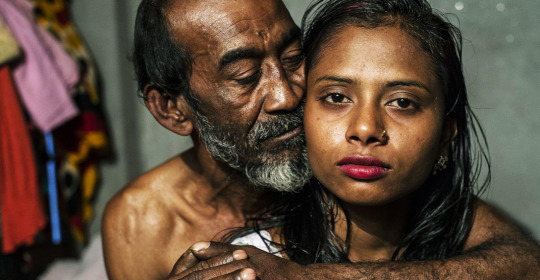
My first brush with the law.
As a freelance journalist, my first and last brush with the law happened around an online article on trafficking. I had written about a wonderful documentary on women. One of the persons mentioned in the film and in my review, filed a defamation charge against the director of the film, the editors of the online magazine and against me for writing. The said person is shown approaching a police station, pretending to be a lawyer, to purportedly ‘rescue’ small girls and give them back to their ‘mothers.’ I later learnt that part of his earnings came from filiing false suits against any Tom, Dick and Harry he felt had defamed him in some way. Instead of putting me off, this incident challenged me to probe deeper into this thriving trade in human trafficking and also to find out how Hindi cinema has dealt with this serious issue.
I went deep into the economics and sociology of trafficking and the details were mind-boggling. Newspapers and magazines are rife with factual stories and case histories of real-life incidents. The human trafficking industry has a reported annual income of $8 billion, and the UN estimates that it may employ as many as 40 million women. Although human trafficking is illegal in almost every country, thousands of girls each year become sex slaves. Even when rescued by social workers, voluntary agencies and sometimes the local police, many of them go back to where they came from, mostly prostitution.
My experience of having watched umpteen films on trafficking, specifically four recent ones, shows that Indian filmmakers’ insight on the subject has evolved over the years. They have moved away from Gulzar’s Mausam, through Sagar Sarhadi’s Bazaar and T.S. Ranga Rao’s hard-hitting Giddh. They are bolder, forthright and not really bothered about what the CBFC has to say.
Related: Busting Child Prostitution In Varanasi | 101 Underground

The ugly world of bride trafficking. Image source: hindustantimes.com
Paro (2017) This short but poignant film draws attention to the illegal business of bride trafficking which goes on unabated, as there are no complaints or if there are, the police look the other way. Vijay Kumar, says he made the film based on a real-life experience, “No one calls the bride by her name because she leads an anonymous life within the family, tending to her bed-ridden husband who is unhappy about the entire situation, but helpless as his mother holds family decisions in her control. The custom of selling the girl as a bride is called Paro Pratha. What shocks is the fact that she accepts her life as a predestined reality and does not know that another kind of life exists beyond this market. She is just a commodity to be bought and sold again and again. All of them have the same name, Paro.” The film is made in Haryanvi because the story, based on true events, happens in a village near Rohtak where Vijay Kumar grew up. If a man buys a paro for Rs.50,000, he will sooner or later, try and sell her off for Rs.60,000, which brings human beings down to the economic laws of supply and demand.

Bollywood and its use of social causes. Image source: hindinews18.com
Mardaani (2014) I went with a friend to watch Mardaani not knowing what it was about but because I am a fan of Rani Mukherjee. Though the movie turned out to be a very unexpected experience. Rani as Shivani is a committed officer of the police force with a supportive husband who backs her despite odds. It’s the story of a powerful ego struggle between the police officer and the kingpin of the trafficking trade. Shivani is taken off the case but she continues to pursue it with the help of a couple of juniors.
I personally had a problem with the title of the film - Mardaani. It’s a well-known acronym for Lakshmibai, the Rani of Jhansi and was bestowed on her because of her manly qualities. But why must a police officer be termed “mardaani”? Is she not equally trained in taking on offenders as much as her male colleagues?
Another issue for me was the climax which shows Shivani pushing the girls to punish the young ring-leader by bashing him up so badly that he lands in a wheelchair. Can, and should, a high-ranking responsible police officer allow the victims to take the law in their own hands?
I felt the director was taking his audience on a jolly ride into girl-trafficking though the motives were distanced from this social issue. They were focussed on showcasing the versatility of Rani Mukherjee as a protagonist who can carry a film without the support of a hero, pure commerce to rake in the money and enlisting itself at film festivals through the subject of trafficking.
Related: The Madam Of A Brothel Told Me, “All That Matters In Life Is Big Boobs And Long Hair.”

13-year olds forced into prostitution. Image source: thecommunityjournal.com
Lakshmi (2014) I had similar problems with the title of this film. It’s ironical because in every second Indian middle-class home, the girl is named Lakshmi, perhaps in the hope that she will augur good fortune for the family. The film is hard-hitting but after a point, it becomes too in-your-face. The process of initiating the 13-year-old girl into prostitution is graphically detailed. The brothel madam teaches her to apply some ointment before servicing her clients to ease the pain. Lakshmi is also given hormone injections to flesh out her body before time, and is repeatedly raped by the pimp Chinna (Kukunoor) because she tries to escape. I personally found the repeated violence on Lakshmi and the other girls visually repulsive and voyeuristic and felt they could have been avoided. Add to this the terribly melodramatic climax that takes away the soul of the film.
At a special screening of Lakshmi for sex workers in a red-light area in Mumbai, Kukunoor was accosted by a group of extremely overwrought sex workers who wanted to know who played the nasty pimp in the film. “Agar woh mil jaye to hum ussey aisa sabak sikhaayenge ki naani yaad aa jayegi” (If we find him, we will teach him a lesson he’ll remember). When they learned that the director himself had played the pimp, the women attacked him till he had to be whisked away. He may have begun with the right intention but did not quite expect this negative reaction.

Love Sonia - a breath of fresh air. Image source: indiawest.com
Love Sonia (2018) The latest in this line is Love Sonia, directed by US based Tabrez Noorani. It’s about a 17-year-old village girl Sonia, who is very closely bonded to her younger sister Preeti. Their world is shaken when Preeti goes missing, actually having been sold by her poverty-stricken father to flesh traders. Sonia goes looking for her and lands up in the same situation. This journey exposes the violent underpinnings of trafficking in human flesh, mainly of very young girls. It travels through the international den of trafficking and sex trade to Hong Kong and Los Angeles.
My personal grouse is with different aspects of the film - the camera focussing on the pained face of the sad father (Adil Hussain) because I feel it rings false. No father can be forgiven for selling his daughter. Scenes are very graphic and violent and many among the audience may not be able to take it. The good thing about the film is the lack of stars, except Richa Chada and Frieda Pinto (if we can call them stars). It is mainly a female dominated film with a peppering of Manoj Bajpayee who does a menacing act well.
Related: A Brothel That Is James Bond’s Namesake, A Bomb Site And Some Dance-Bar Hopping
The question is – are such films genuine attempts to draw attention to trafficking? Or are they trying to piggyback on trafficking to gain easy access to film festivals and awards? The subject lends itself to the voyeuristic instincts of a sex-hungry audience and this can function as a temptation for a new, or a struggling filmmaker to shift focus from social responsibility to titillation and sensation, which will make a producer happy. These films offer scope for a lot of skin show, vulgar dialogues, sensual body language and doses of sex and violence. They are full Bollywood masala - vulnerable girls, shady agents, sex workers, brothel madam, pimp, muscle man, NGO worker and last but not the least, the client.
In the final analysis I feel, though we have moved away from the likes of Mausam and Bazaar, we still have a long way to go. But these recent films prove that cinema is not only for entertainment but also for information, awareness and social change.
Disclaimer: The views expressed in this article are independent views solely of the author(s) expressed in their private capacity and do not in any way represent or reflect the views of 101India.com
By Shoma A. Chatterji Cover photo credit: washingtonpost.com
0 notes
Text
"I Will Sleep Better Tonight Knowing That I Will Wake Up To A Life Of Freedom In Love"

Karan Johar and other Indians share their thoughts on Section 377 being scrapped.
Coming from a small town in India, my own awareness about LGBTQ rights and the constitutional validity of Section 377 remained very limited. That changed when I went for higher studies in Delhi and found out that my roommate identified as a lesbian. She too came from a very small town in Southern India – a town where sex was taboo, and homosexuality was an outright sin. I saw her struggle every day – struggle with her appearance, with her expression of love, with being bullied and name called, and with her own identity – an identity that was left up to law and society to assert.
Throughout the two years that I lived with her, she opened up to me about the girl she so dearly loved but wasn’t able to confess to, about how her family would get her married off to a boy if they ever found out, about being able to assert her right to choice and right to privacy without fearing the law.
It is through her that I realized how I had taken my own freedom and rights for granted in a democratic country where so many people were not even able to express their own individuality. This thought resonated with me even more when I finally moved to Mumbai. At my first ever pride parade as an ally, I spoke to so many people who just wanted to be who they are and love whom they want. They wanted Section 377 to quit India.
It’s been 6 months since the pride parade, and love has finally won today. September 6, 2018 marks an important date in Indian history. A date that is crucial to Indian pride and individuality. In a landmark judgement delivered by the Supreme Court at 11:38 am today, homosexuality is no longer a crime. The verdict was declared by CJI Dipak Misra who, reading out his judgment said, "No one can escape from their individualism. Society is now better for individualism.”
This decision comes almost a month and a half later after a three-bench judge decided to re-examine the constitutional validity of Section 377 that criminalizes homosexuality. This happened post the ‘Right to Privacy’ Act judgement that was passed in August 2017, bringing hope to me as well as thousands of LGBTQI Indians who were in the constant fear of being convicted.
We have to thank the 12 people who filed a petition questioning Section 377, including cultural expert Aman Nath, hotelier Keshav Suri and others for putting up a long, exhausting and relentless fight in the court and finally winning it.
However, like my roommate said, even though legalities may change, it may take our society a long time to break out of their cultural shackles and truly accept people for who they are. The battle has just begun. Nevertheless, with the law on our side, LGBTQ Indians finally have a newfound freedom. A freedom that finally lets them be who they are and love whom they want, a freedom that was long overdue.
In this spirit, we spoke to six Indians who shared their excitement with us, while outlining how life will change for them. Here's what they had to say.

Karan Johar, Filmmaker “Today is a day of empowerment and equality – a day of humanity and finally a day of redemption. More power to all the voices and activists who fought tirelessly for this day. This is their victory more than anyone else’s. I will sleep better tonight knowing that I will wake up to a life of freedom in love.”

Sushant Divgikar, Performer “I would like to say that finally ‘Achhe Din Aa-gay'. But the real fight begins now, the fight with the mindset of people. They have long been conditioned to believe that homosexuality is immoral. Thus, we now need to work on social acceptance. However, I would like to point out that this judgement should not be treated as a ticket to PDA. We have been given this right as equal citizens of the country and that is how we need to exercise it. But I am extremely happy, now that the law is on our side. It will make ‘coming out’ for so many people, so much easier.“
Related: Why Being LGBTQ Is An Ongoing Struggle

Justine Rae Mellocastro, Stylist “The positive verdict is now going to force people to open up their minds about love. That is growth and that is how we grow together as a country. Our goal should be to spread kindness and love to everyone no matter what kind of person they are today so that they can pass it on and it’s a ripple effect.”
Related: Coming Out: Justine's Story

Ashish Chopra, HR professional “As they say, better late than never, I am very happy with the decision. Me and millions of Indians along with me will breathe freedom in the air now and this is a great beginning. We need to start fighting for zero discrimination and equal rights now. This is definitely not the end but the beginning of a new battle. We need to start the fight for marriage rights, zero discrimination policies and a lot more now.”

Ankita Mehra, Community Manager “I have always been open about my sexual orientation. My father reminded me today about the verdict. It is a festival for me, my family and my girlfriend's family. Thanks, Supreme Court, for giving us what we deserve. Now I can say I am truly independent. I am optimistic and proud to be who I am.”
Related: My Walk At The Queer Pride Parade In Guwahati

Arjun Raj, Writer “I came out to my parents just a month ago and while their reaction was more than ideal – they were supportive and unconditionally loving, one of the things they wanted for me was to have a better life, which, they believed- and I did too – would only be outside this country. But this win today proves that there is hope. I'm super grateful to the amazing humans who keep fighting for us and made this win a win. A part of me never wanted to leave this country. I don't think anyone really wants to leave their homeland - they are just forced to. Their sexuality should never be a reason for that.”
Disclaimer: The views expressed in this article are independent views solely of the author(s) expressed in their private capacity and do not in any way represent or reflect the views of 101india.com.
By Devyani Kapoor Cover photo credit : Instagram.com/karanjohar
0 notes
Text
So You Want To Be A Gamer?

It’s not all bad despite the negative press.
It’s that time in the world where they say we’re in the golden age of gaming. With VR (Virtual Reality) and AR (Augmented Reality) coming into the picture, one should make the most of a traditional, yet modern way of gaming. Gaming is never going to be the same once new technology kicks in, but people will still be at it. It’s safe to say (though maybe gaming and safe aren’t considered synonymous anymore) that gaming, especially in India, is no longer just a hobby. If you ask me, I prefer staying in on a weekend and going at it on my PS4. Nonstop.
To clarify, I’m not a pro-gamer. I don’t compete in leagues, heck I don’t even play the MMOs (Massive Multiplayer Online). This is because my family still wants to live in the Stone Age with a 512-kbps internet connection. I also haven’t grown up playing all the old school games that most gamers must have. As a child, I had the cheap rip-off of the PlayStation called the PolyStation. (PS…if you know what I’m talking about, you’re awesome!)

Welcome to the world of gaming. Image source: gamespot.com
Now that you know that I’m not a pro, and you’re still reading, you’re even more awesome. Whether it’s the all-time favourite Super Mario Bros or big platform games like the Final Fantasy series or even GTA for that matter, the world of video games is vast and beautiful, definitely one worth exploring.
Related: What If The Classic Board Game 'Life' Was Suddenly A Video Game?
When you start, especially in the competitive gaming scene, there’s one word you’ll hear the most – NOOB. By definition the word means - a new player or essentially, a bad player. Even when I started out as a PC gamer, (I was young and naive, and thought PC gaming was the bomb) I always thought twice before going online on GArena and playing DOTA or Counter-Strike with players from across the world – What if they think I suck? What if they call me a Noob? What if they ban me from the servers?

The most hated and overused word in the gaming universe. Image source: theknow.roosterteeth.com
But everyone starts somewhere. So here I’m listing a few things you can do to avoid this ‘Online Anxiety.’
1. Call yourself out right when the game starts. Giving a heads up that you’re new to online gaming will give your teammates time to prepare and strategize accordingly. This will give you a strong back-up in case you make any rookie mistakes.
2. Always, and I mean ALWAYS prepare yourself to be trolled. There will be a few times that you’ll be an easy kill. On the in-game chat, the other team players will start trolling you, calling you names and slangs. My advice? Keep a few comebacks ready. For example, if someone kills you, and in the next round you manage a revenge kill, they will call you out by saying “it was a fluke.” There is one sentence that works like a charm here, and that is, “Don’t be salty.” It means - don’t be butt-hurt. Just google it. You’ll come across much more of this as you go along.
If competitive gaming isn’t your scene and you’re like me and love to play by yourself, then this gets even more difficult. There is a lot of research required.
What kind of game do you want to play? What platform do you want to play on? Figure out what type of genre you want to play first. Action, Adventure, Arcade, Platformers, Racing, Shooters, Strategy, Sports, MMOPRGs.

A lot of genres of games, not a lot of time to play them
Related: The Wild West World Of Tabletop Gaming In India
I suggest getting a demo of each genre and playing all of them. You’ll understand what each genre has in store and it won’t hurt your pocket that much. There’s also another question I’ve heard many times – Should I start with retro games first and then move on to the new-age? There is no wrong way to go about gaming. That said, too much of anything is bad. Start with whatever you want. Again, there’s no wrong way.
Now let’s talk PC vs Console. Personally, I prefer the console. But there are many advantages to playing on the PC as well. They are power packed with a lot more control options. However, with new consoles coming up every few months, gaming on the console is going through a tremendous rise. More control over a character, with the additional options of immersive game-play, and also cross-platform gaming that may happen.
One of my ex-girlfriends always wanted to get into gaming but never came around to it. If you’re like her, there is only one thing I can tell you - Take your time and hit up the Internet. There are countless games out there, just waiting for you to take them on.

Let the civil war begin. Image source: youtube.com
Related: We May Have Just Lost Another Life To Gaming
Gaming for money? Well, who wouldn’t like to earn while doing the one thing they love the most? Yes, you can earn by being a professional gamer. If you think you can tutor kids, teens or adults, you can officially give lectures on how to go about a level or beating bosses in a game. This mostly works for the mainstream games like PUBG, Fortnite. There are multiple options that you can find online as well. You can become an official game tester. You get to play the game before anyone else in the world. If you ask me, that is pretty freaking awesome! But it’s a difficult job to get. I’ve tried for Ubisoft (twice), Rockstar games and Naughty Dog games and I’ve been rejected immediately.
You can become a video game commentator, play video games, record the screen, record your face, talk about some random things about the game, throw in a few jokes here and there (the darker the better), edit, upload on YouTube, boom – you’re making money. The biggest YouTuber in the world, PewDiePie, used to be a video game commentator. I rest my case.
So go ahead, press start. An adventure awaits.
Disclaimer: The views expressed in this article are independent views solely of the author(s) expressed in their private capacity and do not in any way represent or reflect the views of 101India.com.
By: Mohit Yagnik Cover photo credit: YouTube.com
0 notes
Text
A BDSM Teacher Reveals A Lot More Than His Fetishes

Sex, kink and powerplay.
“As a teacher, I always want my students to do the right thing, the right way,” says Bharat Singh. “It is important, especially for the subject I teach,” he chuckles, lighting a cigarette and leaning over a polished white table. I realise that what he says, is perhaps the mantra for most teachers across the world. However, this 30 something man with short hair, a dusky complexion and a jolly demeanour isn’t a conventional educator. A successful marketing consultant by day, he is a guiding light to those struggling to find the path to pleasure. Bharat Singh is a teacher of the art of ‘BDSM’. (Bondage, Discipline, Sadism, and Masochism as a type of sexual practice)
Like most teachers, his journey too started off as a student, 10 years ago. Bharat was looking for newer ways and methods to maximize sexual pleasure before he got married, which is when he started experimenting with BDSM. “I had multiple teachers who taught me different aspects about kinks and fetishism,” he states clarifying that most of these teachers were essentially ‘play partners’ with a considerable amount of experience in the subject. This ‘experience’ is what a person needs to qualify as a BDSM teacher, though people with a formal degree in sex and sexuality hold greater expertise.

Experience is required to teach BDSM. Image source: dasniyasommer.de
When asked the reason to formally learn this art as opposed to getting his information online, Bharat smiles coyly and tells me that getting half information is as dangerous as information that is incorrect and not credible; while also stressing upon the importance of doing things the ‘right way’ — which is exactly what is discussed and demonstrated in a typical BDSM class.
Bharat meets his students, either an individual or a couple over coffee or dinner wherein he understands their medical and mental health history. He tells me that sometimes psychological pain could be more traumatic than physical pain, which is why it is important to lay boundaries. Consent is at the heart of BDSM, so it is essential to understand if both the partners are on the same page. He then asks his pupils about their kinks, fets and sexual experience. If everything seems fine, they proceed to the room.
Once inside Bharat makes sure that basic hygiene and safety prevail. Things like rope, needle and candle play need precision else it could be seriously injurious. For example, one cannot drop candle wax on a bare body. It needs to be properly oiled and moisturized. Secondly, hygiene, such as sterilizing needles is important just as the right way to slap, spank, strangulate so that pleasure is maximized and pain is minimum. Teachers like Bharat ensure this by demonstrating it on the students and then by monitoring the act.

One needs to be careful of the hot candle wax. Image source: zest4lifenlove.com
“Contrary to popular belief BDSM is less about sex and more about the exchange of power and emotion, an emotion that isn’t necessarily love," states Bharat. “But have any of your students ever fallen in love with you?” I ask curiously.
He lets out a giggle and tells me that it happens all the time as a lot of people find it hard to separate love and sex, which is why they tend to get clingy. However, as a teacher, he makes it clear in the beginning that the session is strictly a form of education and nothing else.
Bharat is also very particular about the students he chooses. “No minors or virgins. Only people who have had considerable experience with sex. Also, everyone needs to be sober during the class,” he affirms.
Related: A Member Of The BDSM And Indian Swinging Community Reveals A Lot More Than His Fetishes
In the last six years, Bharat has taught many consenting individuals. He works a lot with couples as well. However, most of his clientele constitutes of LGBTQIA students, as they tend to be more explorative. Having conducted countless classes in India, he tells me how the number of people wanting to explore BDSM went up after '50 Shades of Grey' was released. Though it was a very bad example — BDSM isn’t about sexual manipulation but consensual powerplay — it did manage to get a lot of people interested. This is where Bharat’s role became important — to rid people of misconceptions and negative connotations associated with BDSM.

Consent is at the heart of BDSM, be it in any form. Image source: theguardian.com
“If practised properly, BDSM is great for body positivity. It helps you get rid of body image issues by making you very comfortable with your skin as well as your partner’s,” Bharat tells me recounting his own experiences and his own equation with his partner, which he affirms is 'very healthy.'
Related: A BDSM Play-Shop Opens Up The World Of Dominatrix And Submission To Me
Bharat has always been an encouraging educator, not just to his pupils but also to his friends. He is constantly telling them about ways to spice up their sex lives. Though Bharat loves to be a BDSM teacher and he conducts these classes free of cost, he modestly states that he too is constantly learning. The classes he conducts are free of cost and are very open-ended, though there is a clear MoU agreed upon beforehand. Still, there is no escaping awkward sessions and encounters. He tells me, quite amused that sometimes people get angry and walk out. Other embarrassing cases are those of bad odour and prolonged farts.

BDSM spices up people's sex lives. Image source:nytimes.com
Though Bharat is not offering any classes currently, he suggests that interested people look for teachers online – smartly and with care. “The social media is full of lousy, horny people who may not be qualified, so research well,” he warns adding that one can also look out for MUNCHES, which is an informal gathering of people to discuss BDSM and kink and network for one-on-one sessions.
Related: I Became A Moderator For An Adult Fiction Site
India surprisingly has a growing kink community. According to the India Today Sex Survey 2016, nearly 41.8 per cent of Indians practice some form of role-playing, domination or submission. However, in a country where talking about sex and sexuality itself is a taboo, a positive conversation about kink and BDSM is bound to stay behind locked doors for a long time. But it is because of teachers like Bharat that a healthy, safe and most importantly, a consensual practice of BDSM is emerging – which is why we’d like to wish him a very Happy Teachers’ Day!
Disclaimer: The views expressed in this article are independent views solely of the author(s) expressed in their private capacity and do not in any way represent or reflect the views of 101india.com.
By Devyani Nighoskar Cover photo credit: Karan Nevatia
0 notes